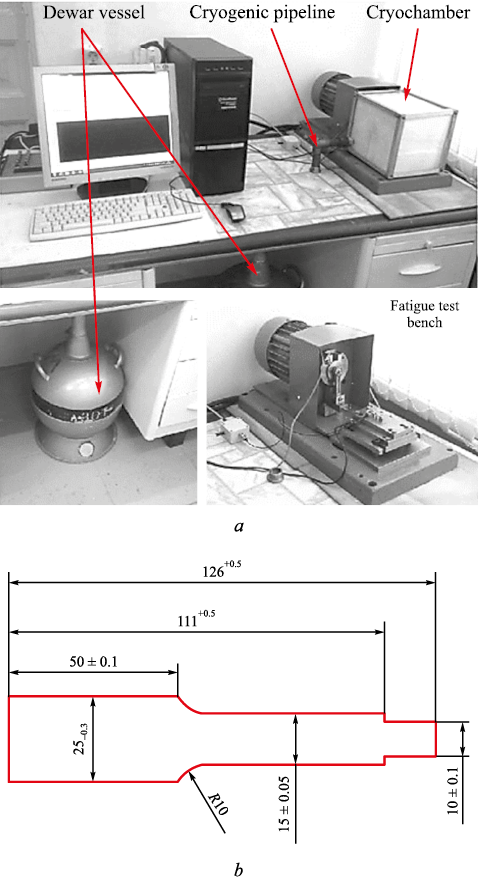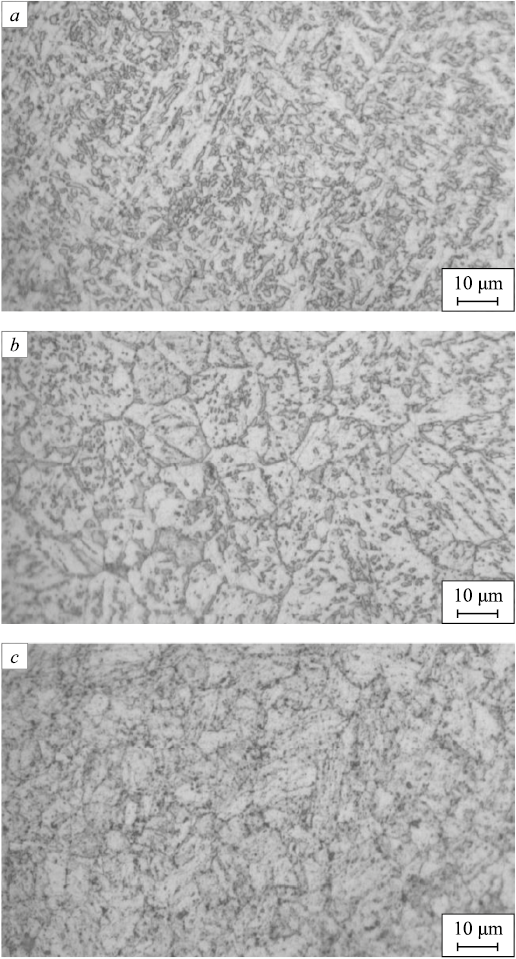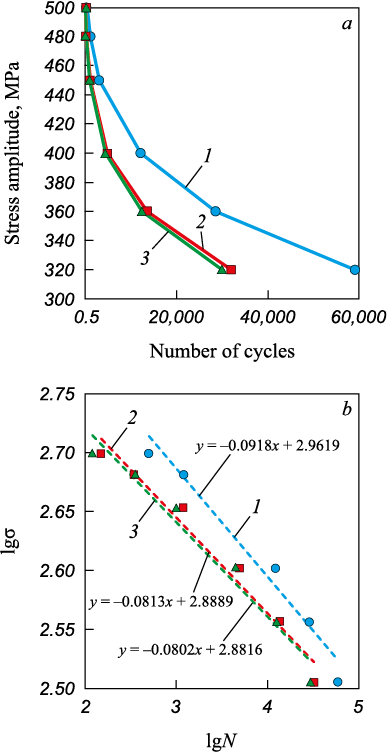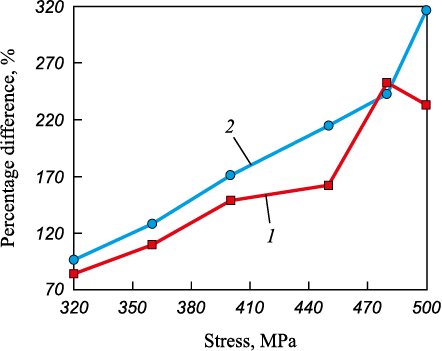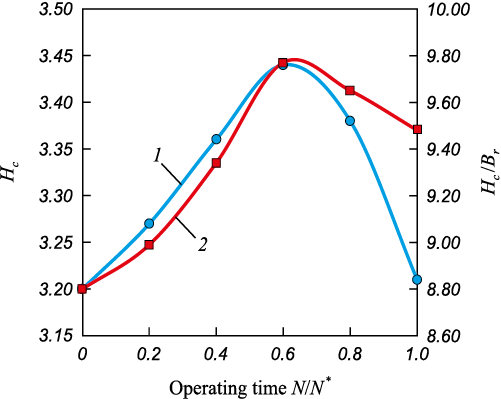Scroll to:
Low-cycle fatigue of welded joint from steel of X70 strength class
https://doi.org/10.17073/0368-0797-2024-4-409-416
Abstract
Steels of X70 strength class are particularly widely used in the field of heavy engineering. One of the most important issues when choosing steel for structures is its behavior under cyclic loads. It is difficult to find a description of the behavior of all zones of the welded joint under fatigue. The purpose of this study was to determine the fatigue characteristics of welded joints made of the Russian analogue of S690QL steel with fixation of acoustic and magnetic parameters for their use in the diagnosis. The objects of the study were the samples from domestic steel of X70 strength class. The chemical composition was determined using optical emission spectrometry. The grinds for microstructural analysis were prepared according to the standard technique with etching in the metal. The fatigue test was carried out on a specialized test bench. The authors used the acoustic system AIS NRK-3 for acoustic measurements and the acoustic parameter D – as an informative parameter. A MA-412MM coercitimeter was applied to evaluate the magnetic characteristics. The following were evaluated: residual magnetization Br , coercive force Hc , Hc/Br ratio. The smallest number of cycles corresponds to the deposited metal zone. The decrease in amplitude showed a significant variation in the behavior of the material depending on the junction zone. However, the curves for heat affected zone (HAZ) and the deposited metal are practically the same. HAZ differs to a lesser extent from the base metal than the deposited metal zone. The graph of the acoustic parameter in its form is the reverse of the magnetic characteristics graph. Thus, there is a minimum for the acoustic parameter, depending on the operating time, and a maximum for the magnetic characteristics. For both graphs, the extremum is the point corresponding to the operating time of 0.6.
Keywords
For citations:
Galkin A.A., Kabaldin Yu.G., Mordovina Yu.S., Anosov M.S. Low-cycle fatigue of welded joint from steel of X70 strength class. Izvestiya. Ferrous Metallurgy. 2024;67(4):409-416. https://doi.org/10.17073/0368-0797-2024-4-409-416
Introduction
High-strength steel with a yield strength of 690 MPa (X70 strength class) is widely used in the production of earth-moving machinery, lifting machines, and cranes [1]. These high-strength steels are often defined as having a tensile strength of 1800 – 2000 MPa [2; 3]. However, in the same industries, steels referred to as High Strength Steel (HSS) in foreign literature are also used, with tensile strength starting from as low as 490 MPa [4; 5].
This class of steel was developed by combining alloying with controlled rolling technologies. It includes: S700MC (standard EN 10149-2); S690Q, S690QL, S690QL1 (standard EN 10025-6); QStE 690 TM (Germany); Strenx 700MC (SSAB); E 690 D (France); A514 (AISI, USA). In Russia, analogous steels have been developed under import substitution conditions.
One of the most important questions when choosing steel for structures is its behavior under cyclic loads, which lead to fatigue failure. Traditionally, low-cycle and high-cycle fatigue are distinguished [6]. Recently, the concepts of gigacycle and even teracycle fatigue (hyperfatigue failure) have been introduced. These are differentiated by the number of working cycles (N) preceding failure:
• low-cycle fatigue: N ≤ 5∙104 cycles;
• high-cycle fatigue: 5∙104 < N ≤ 108 cycles;
• gigacycle fatigue: N > 108 cycles[7; 8];
• teracycle fatigue: N = 1010 … 1012 cycles[9].
This study examines low-cycle fatigue (LCF) – the fatigue of material where damage occurs under elastoplastic deformation in a microvolume. The maximum durability before failure is approximately Nk = 5·104 cycles [10]. Low-cycle failure in mechanical engineering is most often associated with comparatively rare but repetitive overloads. This type can be encountered in any branches of mechanical engineering but is particularly frequent in aircraft engines, aerospace industry, powertrains in the automotive industry, and power plants [11; 12].
Mainly, fatigue resistance characteristics are determined for metal not subjected to welding, or only the behavior of a single joint zone is described [13 – 15]. Therefore, the issue of material behavior under fatigue is more acute for welded joint zones, as such studies are much less represented. It is even more challenging to find information on new grades of materials due to difficulties in obtaining metal for research.
It is well known that the least durable area of a welded joint is either the heat-affected zone (HAZ) [16; 17] or the deposited metal zone, which can differ significantly in chemical composition from the base metal. Considering that welding is a source of defects resulting from physical and structural changes, the fatigue strength of welded joints is lower than that of the base material [18; 19]. It is noted that the weld seam under standard testing methods is the most reliable part of the welded structure, but it becomes the most vulnerable during fatigue testing: characteristics decrease by up to 60 % compared to unwelded metal [20].
Thus, the aim of this study is to determine the fatigue strength characteristics of welded joints made of new domestic steel (analogous to S690QL) while simultaneously recording the parameters of acoustic and magnetic flaw detection for the application of the obtained values in further diagnostics of structures made from the studied steel during operation.
Materials and methods
The study focuses on welded samples made from domestic steel with of X70 strength class. The investigated steel is an analogue of the European S690QL steel. Its chemical composition and mechanical properties, specified in the Technical Standard (TS), are presented in Tables 1 and 2, respectively. For the butt weld, a filler material of 1.2 mm ESAB ArisroRod 69 welding wire was chosen (chemical composition), wt. %: C 0.089; Cr 0.26; Mn 1.54; Mo 0.24; Ni 1.23; Si 0.53).
Table 1. Сhemical composition of the studied steel (maximum content)
Table 2. Mechanical properties of the studied rolled steel
|
The actual chemical composition of the investigated steel was determined using optical emission spectrometry on an ARL 3460 spectrometer.
Preparation of samples for microstructural analysis followed standard procedures (grinding with sandpaper followed by polishing with felt) with etching in nital. Microstructure images were captured using an Altami MET 1C microscope.
Fatigue testing was conducted on a specialized test bench, shown in Fig. 1, a. The test bench includes a fatigue strength testing setup, signal registration, and processing equipment. Acoustic emission sensors were mounted on the sample. The fatigue test sample configuration is shown in Fig. 1, b.
Fig. 1. Fatigue test: |
Loading during testing followed a cantilever bending scheme (cycle asymmetry coefficient R = –1) at a temperature of 20 °C, considering the requirements of GOST 25.502–79. The frequency of elastoplastic cyclic loading was set at 25 Hz. The loading amplitude (σmax) was calculated based on the loading scheme, sample dimensions, and material mechanical characteristics.
For acoustic measurements, the AIS NRK-3 acoustic system was used. The dimensionless parameter D, referred to as the acoustic parameter, was employed as an informative parameter in acoustic emission and is defined by the formula
\[D = \frac{{{c_1} + {c_2}}}{{{c_3}}},\]
where c1 and c2 are the propagation speeds of shear elastic waves with polarization (direction of particle oscillation) along and across the sample axis, respectively; c3 is the propagation speed (delay) of the longitudinal elastic wave [21; 22].
Magnetic characteristics were assessed using a magnetic metal analyzer – coercimeter MA-412MM. The magnetic characteristics evaluated were residual magnetization Br , coercive force Hc , and Hc /Br ratio.
Results and discussion
The chemical analysis showed that the obtained result generally corresponds to the grade composition of the steel (Table 3).
Table 3. Actual chemical composition of the steel of X70 strength class
|
Fig. 2 shows the microstructures of the weld zones of the investigated steel. The base metal consists of fine grains of acicular ferrite with tempered sorbite inclusions. The heat-affected zone contains well-defined grains of ferrite with troostite-sorbite inclusions. The average grain size was 35 μm. The microstructure of the deposited metal consists of spheroidized ferrite and pearlite with sorbitic structures, and traces of bainite. The crystals are oriented parallel to the heat flow.
Fig. 2. Microstructure of butt welded joints: |
LCF tests were also conducted on welded samples in all three zones of the weld joint. The obtained data are presented in Table 4 and shown in graphs in Fig. 3. Most samples of S690QL steel (Russia) failed in the weld zone during LCF testing. This could be due to the deposited metal differing in chemical composition from the investigated steel, resulting in different mechanical properties compared to the base metal. Microstructural heterogeneity also contributes to this: the deposited metal shows signs of a quenched structure, with oriented structural components that reduce ductility and consequently lower the energy threshold for fatigue crack propagation.
Table 4. Results of low-cycle fatigue tests of S690QL steel (Russia)
Fig. 3. Wehler curves for S690QL steel (Russia) | |||||||||||||||||||||||||||||||||||||||||||
The tangent of the slope of the lines in Fig. 3, b (–0.0918, –0.0813, –0.0802) corresponds to low-carbon, low-alloy ferrite-pearlite class steels (e.g., 09G2S).
The comparison of fatigue resistance in the weld zones of S690QL steel (Russia) shows the following results.
• The fatigue curves for all weld zones intersect only in the high-stress region (around 500 MPa). However, this appears so only due to the scale. In reality, at 500 MPa, the number of cycles for the base metal is 230 % higher than that for the HAZ and 320 % higher than that for the deposited metal.
• Further reduction in amplitude shows a significant divergence in material behavior depending on the weld zone. However, the curves for the HAZ and deposited metal almost coincide (both in absolute and logarithmic coordinates). If the percentage difference between the fatigue characteristics for the pairs “base metal – deposited metal” and “base metal – heat-affected zone” is plotted, the resulting graph is shown in Fig. 4. It is evident that the HAZ differs less from the base metal compared to the deposited metal. Additionally, the percentage difference for the deposited metal shows a nearly linear trend compared to the HAZ. Clearly, the greater the stress amplitude, the larger the percentage difference for both zones.
Fig. 4. Percentage difference for welded joint zones |
For the study of ultrasonic parameter changes, additional fatigue tests were conducted with stress amplitudes of 300, 350, and 450 MPa. It was established that the most informative is the pattern of changes in the acoustic parameter D. The study of this parameter was conducted up to the point of main crack formation. The obtained dependencies of the acoustic parameter D on the sample’s operating time N/N\(^*\) (the ratio of the number of cycles corresponding to a given point to the number of cycles recorded during tensile testing) at the investigated stress amplitudes are shown in Fig. 5.
Fig. 5. Dependence of acoustic parameter D |
To determine changes in the magnetic characteristics of the steel based on its operating time, one stress amplitude – 350 MPa – was selected. The corresponding dependencies are shown in Fig. 6.
Fig. 6. Dependence of magnetic characteristics |
The analysis of acoustic parameter changes (Fig. 5) shows that for S690QL steel (Russia), a monotonous decrease in parameter D is observed up to an operating time of 0.6 (except for the curve with an amplitude of 450 MPa), followed by a slight increase before the formation of the main crack.
Fig. 6 shows the dependencies of magnetic characteristics during fatigue loading. Overall, the dependencies of the coercive force Hc and its ratio to residual magnetization (Hc /Br ) correlate with each other and with changes in the acoustic parameter. This dependency remains practically unchanged with varying stress amplitudes. For example, up to an operating time of 0.6, a monotonous increase in magnetic characteristics is observed, followed by a decrease to initial values in the stage before the formation of the main crack.
A similar pattern of changes in acoustic and magnetic parameters with comparable values was obtained for 09G2S steel [21], which can be explained by the chemical composition of the steels (both are low-carbon, low-alloyed) and their structural class (ferrite-pearlite when cooled in air).
Conclusions
The conducted studies have shown that the weakest point under fatigue for the steel of X70 strength class is the deposited metal, due to the difference in chemical composition between the welding wire and the base metal (particularly in carbon content: up to 0.2 % for the steel, and up to 0.089 % for the wire).
The behavior of the weld zones of the investigated steel shows a consistent pattern; however, the fatigue resistance of the deposited metal and the heat-affected zone is significantly lower than that of the base metal. Notably, the number of cycles during fatigue testing decreases more significantly for the deposited metal. It is observed that the greater the amplitude stresses, the higher the percentage difference between the considered weld zone and the base metal.
The dependencies of the acoustic parameter and magnetic characteristics (coercive force, and its ratio to residual magnetization) exhibited extremums at the point corresponding to 0.6 of the operating time on the respective graphs, indicating the formation of a main crack. Thus, the main stage of failure for the steel of X70 strength class occurs when 60 % of the resource is expended.
References
1. Nikolić R., Arsic D., Lazić V. Application of the S690QL class steel in responsible welded structures. Materials Engineering-Materialove Inzinierstvo. 2013;20(4):174–183.
2. Yakusheva N.A. High-strength constructional steels for landing gears of perspective products of aircraft equipment. Aviation Materials and Technologies. 2020;(2(59)):3–9. (In Russ.). https://doi.org/10.18577/2071-9140-2020-0-2-3-9
3. Kablov E.N., Bakradze M.M, Gromov V.I., Voznesenskaya N.M., Yakusheva N.A. New high strength structural and corrosion-resistant steels for aerospace equipment developed by FSUE “VIAM” (review). Aviation Materials and Technologies. 2020;(1(58)):3–11. (In Russ.). https://doi.org/10.18577/2071-9140-2020-0-1-3-11
4. Ivković D., Adamovic D., Arsic D., Ratkovic N., Mitrović A., Nikolić R. Review of the advanced high-strength steels used in the automotive industry review of advanced high-strength steels and their manufacturing procedures. Mobility and Vehicle Mechanics. 2023;49(3):47–64.
5. Cadoni E. High and very-high strength steels under harsh conditions of temperature and loading. Procedia Structural Integrity. 2023;47:348–353. https://doi.org/10.1016/j.prostr.2023.07.090
6. Murakami Y., Nomoto T., Ueda T. Factors influencing the mechanism of superlong fatigue failure in steels. Fatigue & Fracture of Engineering Materials & Structures. 1999;22(7):581–590. https://doi.org/10.1046/j.1460-2695.1999.00187.x
7. Totay A.V., Fedonin O.N., Khandozhko A.V., Petreshin D.I. Technological support of gigacycle fatigue of shaft parts. Transport Engineering. 2023;(11(23)):15–24. (In Russ.). https://doi.org/10.30987/2782-5957-2023-11-15-24
8. Botvina L.R. Gigacycle fatigue - a new problem of physics and mechanics of destruction. Zavodskaya laboratoriya. 2004;70(4):41–51. (In Russ.).
9. Seleznev M.N., Merson E.D. Identification of fatigue crack zones in very high cycle fatigued 42CrMo4 steel with the use of quantitative fractography. Vektor nauki Tol`yattinskogo gosudarstvennogo universiteta. 2019;(3):33–39. (In Russ.). https://doi.org/10.18323/2073-5073-2019-3-33-39
10. Erasov V.S., Oreshko E.I. Fatigue tests of metal materials (review). Part 1. Main definitions, loading parameters, representation of results of tests. Aviation Materials and Technologies. 2020;(4(61)):59–70. (In Russ.). https://doi.org/10.18577/2071-9140-2020-0-4-59-70
11. Rémy L. Low cycle fatigue of alloys in hot section components: progress in life assessment. Procedia Structural Integrity. 2023;14:3–10. https://doi.org/10.1016/j.prostr.2019.05.002
12. Salehnasab B., Hashem-Sharifi S. Low cycle fatigue behavior and life prediction of a directionally solidified alloy. Journal of Design Against Fatigue. 2024;2(1):1–10. https://doi.org/10.62676/ygye8n63
13. Zhu Z., Qianshuo F., Wang B., Zheng W., Yu Y. High-cycle fatigue performance of the heat-affected zone of Q370qENH weathering bridge steel. Journal of Materials in Civil Engineering. 2024;36(4):17056. https://doi.org/10.1061/JMCEE7.MTENG-17056
14. Grönlund K., Ahola A., Riski J., Pesonen T., Lipiäinen K., Björk T. Overload and variable amplitude load effects on the fatigue strength of welded joints. Welding in the World. 2023;68:411–425. https://doi.org/10.1007/s40194-023-01642-z
15. Tang Z., Cai Z., Wu J. Influence of element segregation at grain boundary of heat affected zone on low-cycle fatigue property of weldment. Journal of Mechanical Engineering. 2015;51(14):78–85. https://doi.org/10.3901/JME.2015.14.078
16. Vasechkin M.A., Egorov S.V., Kolomenskii A.B., Chertov E.D. Temporary tensile strength of welded structures made from domestic and foreign materials. Proceedings of the Voronezh State University of Engineering Technologies. 2015;(4(66)):61–65. (In Russ.).
17. Leshchik S.D., Zhukovski V.E., Noshchik R.A. Influence of forced cooling of the weld and heat-affected zone during welding on the welded joint characteristics. Vesnik Hrodzenskaha Dziarzhaunaha Universiteta Imia Ianki Kupaly. Seryia 6. Tekhnika. 2023;13(1):45–55. (In Russ.).
18. Song W., Liu X., Razavi N. Fatigue assessment of steel load-carrying cruciform welded joints by means of local approaches. Fatigue & Fracture of Engineering Materials & Structures. 2018;41(12):2598–2613. https://doi.org/10.1111/ffe.12870
19. Płaczek D., Maćkowiak P., Boroński D. fatigue analysis of welded joints using a thin-walled Al/Fe explosive welded transition joints. Materials. 2023;16(18):6259. https://doi.org/10.3390/ma16186259
20. Gridasova E., Veretkovskiy A., Safariants A. Review of research of fatigue properties of welded joints under high-frequency loading. FEFU: School of Engineering Bulletin. 2019;(2(39)):3–11. (In Russ.). https://dx.doi.org/10.24866/2227-6858/2019-2-1
21. Anosov M.S., Ryabov D.A., Chernigin M.A., Solovyov A.A. Non-destructive testing of the accumulation of fatigue damage in steel Sv-09G2S produced by wire arc additive manufacturing. Vestnik of Nosov Magnitogorsk State Technical University. 2023;21(2):47–53. (In Russ.). https://doi.org/10.18503/1995-2732-2023-21-2-47-53
22. Khlybov A.A., Ryabov D.A., Solovyov A.A., Anosov M.S., Matveev Yu.I. The effect of plastic deformation on the structure and properties of 20CrMnSi steel obtained by additive electric arc cultivation. Russian Journal of Water Transport. 2023;(75):95–107. (In Russ.). https://doi.org/10.37890/jwt.vi75.382
About the Authors
A. A. GalkinRussian Federation
Andrei A. Galkin, Postgraduate of the Chair “Technology and Equipment Engineering”
24 Minina Str., Nizhny Novgorod 603022, Russian Federation
Yu. G. Kabaldin
Russian Federation
Yurii G. Kabaldin, Dr. Sci. (Eng.), Prof. of the Chair “Technology and Equipment Engineering”
24 Minina Str., Nizhny Novgorod 603022, Russian Federation
Yu. S. Mordovina
Russian Federation
Yuliya S. Mordovina, Engineer of the Chair “Technology and Equipment Engineering”, Postgraduate
24 Minina Str., Nizhny Novgorod 603022, Russian Federation
M. S. Anosov
Russian Federation
Maksim S. Anosov, Cand. Sci. (Eng.), Assist. Prof. of the Chair “Technology and Equipment Engineering”
24 Minina Str., Nizhny Novgorod 603022, Russian Federation
Review
For citations:
Galkin A.A., Kabaldin Yu.G., Mordovina Yu.S., Anosov M.S. Low-cycle fatigue of welded joint from steel of X70 strength class. Izvestiya. Ferrous Metallurgy. 2024;67(4):409-416. https://doi.org/10.17073/0368-0797-2024-4-409-416



